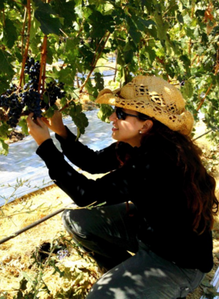 |
| "Making pretty wines in the Pacific Northwest, one barrel at a time. 100% inspiré par les vins de Loire!" Leah Jørgensen created her own interpretations of Loire style wines based on site selection, taking a close look at what the vintage is giving her. She has worked in every capacity of the wine industry (aside from vineyard management) for the past fifteen years. She began working in the Oregon wine industry in 2004, starting at Erath Vineyards in Dundee, transitioning to Ste. Michelle Wine Estates in Woodinville, WA, and returning to Oregon to work for Adelsheim Vineyard, before offering marketing consulting for a handful of wineries. At the same time, she studied enology for two years at the Northwest Viticulture Center in Salem. She worked her first full harvest at Anne Amie Vineyards in 2009, followed by two years of cellar work at Shea Wine Cellars in 2010 and 2011. She also assisted Shea winemaker Drew Voit with his Harper Voit wines both vintages, and crafted her first small lot of Cabernet Franc in 2011. In 2012, she went on to assist winemaker Tom Fitzpatrick as his sole harvest intern at Alloro Vineyard while working on her second vintage at a new winemaking facility on Beacon Hill Vineyard in Gaston. Leah knew she wanted to make wine the moment she visited Oregon, although she initially had an inclination to ferment grape juice back when she worked at a small winery in Virginia. It took her only a decade to realize that dream. The desire to work with Oregon fruit is definitely a nod to her father’s agricultural roots, as he grew up on a small family farm outside of Eugene. Her ultimate dream is to buy that land back one day, plant a vineyard and name it after her grandparents. Leah's passion for the Loire Valley stems from her experience working for the distributor that represented Louis Dressner Selection in her hometown of Washington, DC. Her signature, limited Blanc de Cabernet Franc is the very first commercial still white Cab Franc made. In 2012, she added the Oregon “Tour Rain” Vin Rouge, a fruity Gamay Noir/Cabernet Franc blend inspired by the Touraine region in the Loire, and a 100% “Flat Track” Cabernet Franc – Limited Roller Derby Edition, with a portion of the proceeds benefitting Portland’s Rose City Rollers league and associated charities. The 2015 vintage in Southern Oregon began with warm weather conditions in the winter that continued throughout spring and summer. Full irrigation commenced early in the season to hydrate the soils. Bud-break occurred about two weeks ahead of schedule. The season started out warm and had absolutely perfect weather all summer, with some heat spikes in July and August, with perfect ripening weather all the way through to the end. The heat contributed to an early harvest - about two weeks ahead of schedule - but, with fruit that was concentrated and balanced. Deficit irrigation was used as needed, per site, and leaves were pulled right after fruit set. Leah had the luxury of being able to choose the grapes based entirely on flavor, seed color and skin tannins, not weather. In 2016, Oregon saw its earliest vintage on record, providing exceptional fruit quality with closer to normal yields. An unusually warm spring gave way to moderate summer conditions, with even growing conditions through véraison; however, it was an intense growing season due to the early start. Fruit throughout the state showed excellent concentration and complexity with characteristic natural acidity. Bud break initiated the vintage two to four weeks earlier than normal. Warmer than normal conditions in most areas in August brought on the early vintage and many vineyards in Southern Oregon started to harvest white varieties as early as the second week in August, with early ripening red varieties as early as the last week of the month or in early September. Many Southern Oregon vineyards adapted to the third straight year of early and warm vintages by initiating night harvesting, allowing growers to deliver cold fruit to the winery and wrap up picking each day by mid-morning. The late ripening reds had plenty of time to develop dark colors, good tannin structure, and dense, concentration of flavors with impeccable balance. |
| Leah Jørgensen Cellars Website |
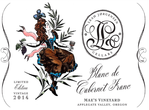 |
| Blanc de Cabernet Franc |
| Appellation: Applegate Valley - Vineyard: Mae’s Vineyard. Located in the Applegate Valley in Southern Oregon, Mae’s Vineyard is owned and managed by Herb Quady (Quady North Wines). Planted in 2006, the vines are trained on a “V” type trellis that splits the canopy, allowing for lots of leaf area and diffracted light. The vineyard is planted 45 degrees to the east of North, giving more even light exposure during high summer, with south southeast exposure. The soil series is “Manita”, gravelly loam, granitic with red/yellow dirt. The Cabernet Franc clone is 214 on 3309 root stock. Mae’s Vineyard is LIVE Certified. This is the first commercially produced still white wine from Cabernet Franc grapes. The grapes were gently whole cluster pressed, like a white wine, to avoid the influence of pigment and tannin contained in the skins. The juice settled in tank for 24 hours, then was transferred into equal parts neutral oak and stainless steel barrels for fermentation, where the wine remained on the lees with regular bâtonnage to add richness, complexity, and an interesting briny, salinity to the finish. Delicate nuances of “early blush” apricot, golden raspberries, Meyer lemon, blood orange, white tea leaf, tarragon, and hazelnut add to this pretty, complex white wine from red grapes. This vintage, the wine also offers subtle botanical notes of elderflower, jasmine, lime blossom, sweet pea shoot, even a hint of ground cinnamon, with flavors of clementine, lemon meringue, light honey leading into a creamy and nutty mid-palate that finishes with refreshing salinity. Drink now for freshness, but this wine will age in the bottle for a couple years from the initial phenolics provided by the red skins. 95 cases made, 12.5% alcohol. |
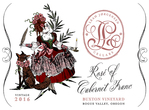 |
| Rosé de Cabernet Franc |
| Appellation: Rogue Valley - Vineyard: Buxton Vineyard. Buxton Ranch is a twenty-five acre vineyard on a south-facing slope located between the Upper Table Rock Plateau and the Rogue River in Southern Oregon. Because of the vineyard’s close proximity to the river, the soils are comprised of round river rock and alluvial silt. The river rocks influence the vines with a healthy struggle, with the resulting fruit showing depth and concentration of fruit character. The river rocks also bring thermal energy into the vineyard, adding heat during the long summer days, allowing the grapes to fully ripen and and develop intense varietal flavors. The vineyard has excellent air movement and benefits from the Rogue River's moderating influence and daily evening breeze that cools the vineyard overnight. In 2016, Oregon saw its earliest vintage on record, providing exceptional fruit quality with closer to normal yields. The Cabernet Franc lot for this rosé was picked on September 3rd at 21.2 Brix. Because of the heat, the fruit arrived at the winery via refrigerated trailer, and was gently whole cluster pressed with simple maceration for the juice to extract color and flavor from the skins. The juice remained cooled and settled in a chilled stainless steel tank for 3 days, was racked off sediment and returned to the stainless steel tank for fermentation, with starting temperatures nice and cool, allowing for a slow, steady fermentation. The wine was racked once during fermentation for movement, immediately developing the aromatics that have been captured in the bottle. The wine remained cellared in tank until bottle preparation. The wine was stabilized, filtered and bottled in February. This rounded rosé bursts with wonderful aromatics - at first, a fresh, sweet garden of heliotrope, moonflower, tea rose and sweet pea; then, a whirl of whimsical cotton candy, marshmallow and marzipan; finally lingering with fresh fruit scents of pink or star ruby grapefruit, golden harvest raspberries, and ripe apricots! It tastes that way, too. Mostly the dry, brightly acidic pink grapefruit in a glass. Plus, orange marmelade, green strawberries, summer fruit salad. 11% alcohol. 110 cases produced. |
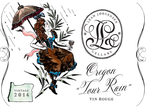 |
| Oregon Tour Rain - Vin Rouge |
| The 2014 vintage in Southern Oregon started with an extremely dry, intensely cold winter. The ground was absolutely parched at the beginning of the season, and full irrigation commenced as soon as the canals came on just to hydrate the soils. Bud-break occurred about two weeks earlier than normal. The season started out warm and had absolutely perfect weather all summer long, with no heat spikes and perfect ripening weather all the way through to the end. Leah had the luxury to choose exactly when to pick the grapes based entirely on flavor, seed color and skin tannins, not weather. In the Willamette Valley, from bud break through harvest, it was an almost ideal growing season that delivered a record amount of exceptional, balanced fruit. An early season showed an average of two weeks early from bud break through harvest. Growing conditions were mostly dry and warmer than normal throughout the spring, providing a nice flowering and fruit set, resulting in large clusters that ripened evenly over the course of the warm, dry summer. The 2014 vintage broke the previous record for heat accumulation during the growing season, set in 2006. This record was broken not by the daytime highs but rather the overnight lows being higher than normal for most of the year. This allowed the grapes to continue ripening through véraison without putting heat stress on the vines. Fruit came in with the perfect balance of ripeness, pH, and acidity. Two vineyards and two appellations make up the two grapes in this blend. The Cabernet Franc is from Mae’s Vineyard, which is located in Southern Oregon’s Applegate Valle, and is owned and managed by Herb Quady (Quady North Wines). The vines were planted 45 degrees to the east of North, giving more even light exposure during high summer, with south-southeast exposure. The Gamay was sourced from Havlin Vineyard, which is situated in the east end of the of the Willamette Valley’s Van Duzer Corridor in the Perrydale Hills, where the grapes benefit from the rapid cooling affect of the Van Duzer winds. Both vineyards are sustainably farmed and are LIVE Certified. This wine is inspired by the Touraine red blends from France’s Loire Valley that are centered around Gamay. This Oregon version, whimsically called Oregon “Tour Rain”, is comprised of 45% Gamay and 55% Cabernet Franc (it will always be about a 40/60 ratio). The Cabernet Franc was harvested first on Oct. 4 at 23.4 brix, went through traditional short vating (5-6 days), and was sorted, de-stemmed, crushed lightly (half whole berry, half crushed), with a four-day cold soak, starting fermentation at 55° F so as to have a slow, extended fermentation, with manual punch-downs twice daily during fermentation. It was aged in French oak barrels. Malolactic fermentation completed in two months. The Gamay was harvested first on Oct. 11th at 23 brix, and was sorted, de-stemmed, whole berry crushed, with a four-day cold soak followed by manual punch-downs twice daily during fermentation, then aged in neutral French oak for 7 months, with malolactic fermentation completed in two months. The wine was racked, blended, then filtered prior to bottling. This blend is a lovely balance of floral, red fruit and a hint of pepper and sweet wood - with aromatics of cherry, raspberry, hibiscus, rose petals, cedar, cigar box, and flavors of bing cherry, raspberry, cocoa powder, clove, and roasted bell pepper, this wine has bright acidity and is juicy with rich, soft tannins. Enjoy slightly chilled (cellar temperature/58-64° F). 13.7% alcohol. 240 cases made. |
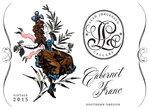 |
| Cabernet Franc - Southern Oregon |
| Fruit was sourced from Crater View Ranch and Sundown Vineyard, both in Southern Oregon, and both sites are LIVE Certified. These two sites were harvested on September 19th (Crater View) and 20th (Sundown) at an average of 24 brix, and were sorted, de-stemmed, and crushed lightly (half whole berry, half crushed), followed by a four-day cold soak. Fermentation commenced at 55° F so as to have a slow, steady fermentation, with manual punch downs twice daily. The wine was aged in mostly used French oak barrels, along with some stainless steel, to tone down the intensity from the skin and wood tannins. A slow, steady malolactic fermentation completed in three months. The wine was racked, blended, then filtered prior to bottling. "This wine expresses fresh, bright, vibrant aromatics lifting and floating above the glass, brimming with intense floral notes, perfume, and sweet fruit. This wine was like a bouquet of flowers saved from a precious occasion, hung carefully upside to dry and preserve the natural oils - rose petals, hibiscus, violets, carnations. It reminded me of a delicate floral fragrance I wore when I was a young woman - "Petite Chérie" by Annick Goutal - not for the individual scents of pear, peach, musky rose, freshly cut grass, and vanilla (those descriptors really sound more like a portrait of white wine, anyway), but, for the sum of its parts, the alchemy of these scents that, when coalesced, create something that smells nothing like the individual oils, but, something of a magical emanation created by some ethereal woodland fairy queen. Then, another swirl of the glass sparked cinnamon bark, cigar, sweet birch bark, the distinctive spicy-citrus aroma of black walnut leaves, brambles, and ripe cherries. On the palate, this is a dry wine with ripe fruit flavors of black cherries, raspberry, cherry tobacco, anise, spice, and black pepper on the finish. It’s light and lithe, but with firm tannins on the finish - this wine will age gracefully". 14.5% alcohol. 243 cases made. |
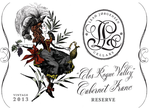 |
| Clos Rogue Valley - Cabernet Franc Reserve |
| Owned and farmed by Quail Run Vineyards, the Sundown Vineyard is the source of some of Leah's best lots of Cabernet Franc. Planted in 1999 in silty loam soils, the Cabernet Franc blocks in this vineyard include both cordon trained vines and the Scott Henry trellis system, with slight eastern aspect leading to steep terraces backed by high mountains, offering high sunlight with protection from afternoon heat, leading to cool evenings. The canopies are closely managed to minimize methoxypyrazines to balance the typical varietal green and vegetal characters, and to bring out more of the intense floral and fruit character of the wine. Sundown Vineyard is Salmon-Safe, Oregon Certified Sustainable, and LIVE Certified. The season started relatively early, warm, and dry. Frost events set in relatively late, with temperatures briefly dipping to 27F in late April. Bud break was in mid-April, about 1 week earlier than normal. Because of very dry conditions irrigation started relatively early and continued through fruit set. At fruit set, any third clusters were dropped, along with any clusters on short or week shoots. The post veraison period was nearly ideal, with warm days and relatively warm nights throughout August and September. There was one rain event in late September, but it only totaled about seven inches. Because moderate ground moisture levels were maintained throughout ripening, there wasn’t dilution, only a small pause in ripening. This site was harvested on October 16th at an average of 23.5 - 24 brix, and went through traditional short vating (5-4 days), then was sorted, de-stemmed, crushed lightly (half whole berry, half crushed), with a four-day cold soak, starting fermentation at 55° F so as to have a slow, extended fermentation for a few weeks after the wine went dry, with manual punch-downs twice daily. These ‘best lots’ were aged in new French oak barrels, including one puncheon. A slow, steady malolactic fermentation completed in four months. After aging fifteen months in barrel, the wine was racked, blended, then filtered prior to bottling. This elegant, complex wine opens with aromas of island hibiscus, vanilla bean, a hint of amaretto, sweet cherry tobacco, and lapsang souchong black tea. Its sweeter fragrance is gracefully juxtaposed by the herbal palate that opens with a bite of acidity, then wanders into a pleasant blend of flavors, including cola, bitters, Amarena cherries, spicy cloves, ground pepper, fennel, black olive, and nettles, and finishes with firm, well-integrated tannins. It’s lighter body makes for a lovely accompaniment to many foods. 14% alcohol. 66 cases and 36 Magnums made. |
| Printer Friendly Version |
| Copyright © 2002-2017 VOS Selections, Inc. |